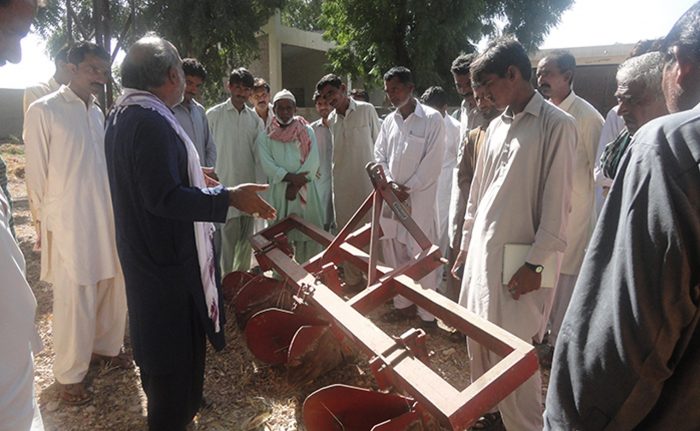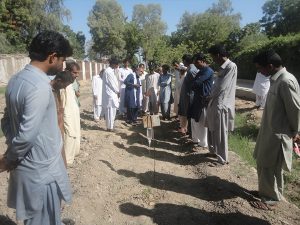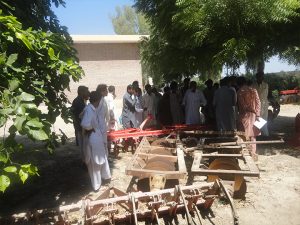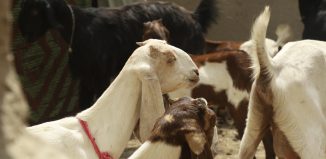Improving agricultural prospects through farmers’ exposure and coaching

An exposure visit of fifty-five rural farmers from different villages in Badin, Sindh, to the Wheat Research Institute (WTI) in Sakrand, Central Cotton Research Institute (CCRI), Agriculture Training Institute (ATI) and the Seed processing unit of Sindh Seed Cooperation took place in September. This visit was conducted as part of building the capacity of rural farmers on adopting sustainable agricultural practices, under the CFGB supported, Sustainable Farming and Food Security project implemented in Sindh, Pakistan.
Through this project, together with the participation of the farming communities, we are promoting the production of food, fiber, and other produce using farming techniques that aim to protect the environment, public health, communities, animal welfare as well providing long-term development and food security among the communities. Most of these Sindhi communities are most affected by climatic hazards and the adverse impact of climate change.
Muhammad Yousif Channa, Senior Instructor at ATI and Coordinator of Integrated Pest Management (IPM) Unit, Sakrand facilitated this farmers’ exposure visit. The work and development of high yielding new wheat varieties of WTI were shared with the farmers and the two new wheat categories, of early and late sowing, released by WTI, were introduced to them.
The farmers then visited the Wheat Museum where different varieties of wheat were on display. The different types of machinery in use to implement the diverse practices used for wheat crop management were shown to the farmers. This learning was essential to the rural farmers’ knowledge as they could see it’s practical implementation, enabling them to easily apply it in their own farming to ensure successful integration of sustainable agricultural practices in their villages.
Ashraf Soomro, Director at the WTI, Sakrand, engaged the farmers in an interactive discussion to identify and address the issues they face in crop management. While responding to questions about water shortage Ashraf Soomro recommended sowing wheat on Ridge, which was also demonstrated to them, as it would save 30% to 40% of the water. He also shared with them hand bills and a booklet on wheat production technology.
At the CRRI, the farmers watched a presentation on the institute itself, the many cotton varieties it has developed and most importantly on cotton pesticides and the damages it does. The Senior Scientific Officer at the institute, then went on to talk about insects that are beneficial to crop growth and how those can be managed. During these presentations, it was learnt that development of different cotton takes 10-12 years.
The Plant Physiologist at CCRI delivered an in- depth presentation on crop production technology, focusing on soil analysis and fertility management, for the farmers. He emphasized on the importance of soil analysis, without which it would be impossible to identify if the soil is enriched with nutrients or not.
After the CCRI, the farmers’ visited the Seed Processing Unit of the Sindh Seed Corporation. The focal person at the Unit, shared and demonstrated the process of adulteration, the removal of broken and shriveled seeds, and the process of seed grading, to ensure the production of the best seed quality.
As the last stop of the exposure visit, the farmers were introduced to the Agriculture Training Institute (ATI) and to different methods of adopting sustainable agriculture practices. The Senior Instructor at the ATI demonstrated different and cost effective methods of farming. These included compost making, plantation with pitcher irrigation, drip irrigation by using water material, propagation via air layering and organic gardening, all carried out at the ATI.
Ashraf Memon, Instructor and Veterinary Doctor at ATI, not only shared better livestock management practices but also responded to queries and prescribed medicines and indigenous techniques to control the various diseases.
The farmers were very appreciative of this exposure and learning opportunity. Not only did they learn various crop management techniques first hand but would also take back the learnings to share among their farming communities. For them it was much appreciated the visit as they learned different techniques of cop management which will be useful for them to implement in their field of work.
Ghulam Mustafa Kaloi, farmer from Babar Kaloi village, Badin.Since our forefathers’ time, we used to sow either by placing the seed or a vegetative part of the plant in the soil. The technique of Air Layering, i.e. to make new plants from the branch which is in the air, was very new and we couldn’t ever imagine that we could produce a new plant this way. This exposure visit has taught us innovative techniques of farming which can be beneficial for us.
Muhammad Zaman Lalial, Ghulam Hussain Lalial village, Badin.It was the first time for me to ever visit such specialized institutions. Visiting the Cotton Research Institution was a great opportunity for us to witness and learn how to develop new cotton varieties and manage pests through an integrated approach.
Ahmed Khan, Muhammad Sheedi village, Badin.We waste many thing which, if processed properly, can be very productive for the land. One of the example is the dispose off the medical infusion drips after utilization however we have learnt that that wasted drip can further be used for drip irrigation where there is scarcity of water. This was a new learning for me at the Agriculture Training Institute Sakrand. Water scarcity is a serious issue in our village and we cannot afford expensive irrigation Drip and Sprinkler irrigation systems due to our weak financial status. I learnt the simple and no-cost DRIP irrigation technique by using the waste material at the ATI and I applied that technique at home for kitchen gardening. I am very thankful for being given this exposure visit as it has taught me a lot.









